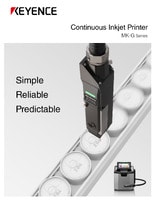Continuous Inkjet Printers / Case Coder
Materials and Products
Production Machines
Printing Applications
Basics of Date Coding
What is date coding? Date coding is a process of marking a product with a date that indicates when a particular product is manufactured, packaged, or should be used or sold. This practice is generally required in the food and pharmaceutical industries but is a critical component of tracking and traceability in most other industries as well.
Date coding is a small but critical aspect of manufacturing, containing production-related information, which is essential for both consumer and manufacturer traceability. For example, date coding on perishable goods often serves to help consumers determine product freshness, while batch numbers (also a part of date coding) help manufacturers identify defective products.
The use of date coding also extends beyond just these utilitarian reasons; the coding is often mandated by federal regulation depending on the specific industry, especially for perishable goods such as food and medicine.
Types of Date Coding
Date coding differs from industry to industry, but most consumer products have their manufactured date and lot/batch number printed on the label. Manufacturers use a range of different labels and codes for different purposes. Some codes are used to keep track of inventory and stock levels, while others provide valuable information to consumers.
Due to the diversity of regulations governing each industry, there are several different types of date codes, and some of the most common examples are included below.

KEYENCE ultra-high-speed and non-contactindustrial inkjet printers can be easily installedon existing packaging machines.
Through built-in sensors and optimization, flawless and clear marking of expiration datescan be achieved.
“Best By” Dates or Expiration Dates
Expiration dates are the best-known and most commonly used date codes in manufacturing, and they’re typically presented in a few different configurations depending on preference and standard. There’s also a difference between “best by” and “best before,” but we won’t dive into the legalities of said codes.
Both codes let retailers and other businesses know the day, month, and year at which the product should be pulled from the shelves. They also inform consumers when the product becomes unsafe for use or consumption.


Packaging Date Codes
These are similar to expiration date codes; pack dates aren’t mandatory or regulated across various industries. The exception to this rule is the packaging date of infant formula, which is mandated by FDA regulations.
Still, it’s important to note there are some industries, such as manufacturers of dairy products, beer, poultry, and eggs, that voluntarily provide this information because the freshness of the product is directly related to the quality of goods.


Lot/Batch Codes
Lot/batch codes aren’t aimed at consumers but at manufacturers. They’re often unique combinations of letters and numbers put on products for record-keeping and inventory purposes.
Lot numbers allow companies to perform faster quality checks, determine expiration dates, and even issue recalls when necessary. The form of the code depends on how the information is useful to and interpreted by the manufacturer of particular goods.


We’re here to provide you with more details.
Reach out today!

Benefits of Advanced Date Coding Machines
Despite vast differences between industry-specific coding regulations and standards, having the right hardware for date coding is a must for many businesses. It’s important to note that date coding printers aren’t the type of equipment you want to cut corners as illegible codes and misprinted information were the downfall of many businesses.
Do You Know How Many Mistakes Your Coder Is Making?
![Food accident categories: [1] 29%, [2] 28%, [3] 19%, [4] 23%, [5] 1%](/Images/basics-of-date-coding_img_08_2127192.jpg)
According to the food accident information notification network produced by the Japan Food Industry Association, 19% of food accidents were due to mistakes in the displaying of expiration dates.
-
1Display mistakes
-
2Mixing of foreign objects
-
3Expiration date mistakes
-
4Other
-
5Defective packaging
![Expiration date mistake categories: [1] 81%, [2] 16%, [3] 3%](/Images/basics-of-date-coding_img_09_2127193.jpg)
Furthermore, among all the errors caused by expiration date mistakes, 81% were caused by the date being displayed incorrectly. In another 16% of the cases, printed text was missing in whole or in part.
-
1Incorrect date printed
-
2Missing printed text
-
3Other
Additionally, advanced date coding printers offer precise and consistent print quality, as well as compatibility with numerous printing substrates and often with numerous ink types. And while the initial costs of these devices might be higher, they’re often more cost-effective in the long run.
Despite the fact that a date code is a small aspect of the manufacturing process, it is commonly a choke point for production. A reliable and high-speed CIJ printer is critical to maximizing production.
It’s also important to mention that many of these printers integrate with other manufacturing and packaging systems, which enables a more automated and streamlined production and labeling process.

Inspection device linking with just a LAN cable
With a KEYENCE inkjet printer, the expiration date or the manufacturing date can be updated automatically. This prevents setting mistakes during date printing, which make up 81% of all expiration date mistakes.
The MK-G Series inkjet coder can be easily linked to a print inspection device by connecting a LAN cable. There is no need to create software, a time-consuing task, which greatly reduces the installation cost.
KEYENCE vision system provides peace of mind in the rare case that printed text is missing. The device ensures unacceptable products are not released in th event printed details are missing or incorrect, providing an extra layer of reliability.
Get detailed information on our products by downloading our catalog.
View Catalog

Applications of Product Date Coding
Though code dating differs from one industry to the other, and depending on the type of code, it also differs among manufacturers; there are some universal applications of product date coding.
Date coding is most commonly used in food packaging, especially when we account for increasingly complex logistics that demand proper traceability of perishable goods due to higher contamination risks associated with complex supply chains. The same applies to beverage bottling and canning.
Pharmaceutical companies are subject to even stronger labeling and date coding requirements than the food and beverage industries from the FDA, which states that all labels must be legible and properly placed throughout storage, transport, and use.
The electronics industry also relies on date coding. While these products don’t expire traditionally, date coding offers information for quality tracking and warranty purposes. Truly, the list of industries relying on some form of date coding is vast.
Curious about our pricing?
Click here to find out more.

Considerations for Choosing an Expiration Date Coding Solution
There are several key factors worth considering when choosing an expiration date coding solution, and most of these stem from your particular application.
For example, different date coding solutions work better with different materials, so considering the nature of the product and its packaging is really important. Most modern date coders are compatible with different printing substrates, such as glass, plastic, metal, paper, wood, etc.
Print durability and print quality are also important considerations. For example, there’s no need to invest in solutions that print durable codes for products with a relatively short shelf life. When deciding on print quality and durability, it’s also important to consider the storage environment—external factors might influence print durability.
Technical specifications, such as speed, efficiency, flexibility, industry-specific standard compliance, and ease of integration in pre-existing systems, are all crucial factors worth considering when choosing a date coding printer best suited for your application.
Discover more about this product.
Click here to book your demo.

Summary
Date coding is a process of printing valuable information about the product for both consumers and manufacturers. As such, its legibility, durability, and quality of print are closely tied to the quality of the date coding printer equipment, which is why you shouldn’t shy away from investing.
If you’re interested in date coding printers, contact KEYENCE and check out their MK-G date coding printer series.
Get detailed information on our products by downloading our catalog.
View Catalog

Related Downloads

This guide explains continuous inkjet (CIJ) printer applications together with pictures and illustrations. It contains many installation examples in various industries divided into food, medicine, and cosmetics; electrical machinery and electronics; and automotive, metal, and others. These examples show printing on targets specific to each industry.
![Inkjet Printer Tech Guide [BASIC KNOWLEDGE EDITION]](/img/asset/AS_114378_L.jpg)
Continuous inkjet (CIJ) printers work by discharging ink particles to print information such as characters and figures on targets. This document describes the differences between industrial use inkjet printers and office-use printers, as well as their structures, circulation principles, and application examples.
Related Products
Applications
Materials and Products
- Glass Bottles
- Plastic Bottles/Containers
- Cans
- Wires, Cables, & Pipes
- Pouches
- Metal Parts
- Corrugate Boxes
- Packaging Film
- Kraft Packaging
- Folding Cartons
- Building Materials
- PCBs
- Cartons
- Pallets & Lumber
- Corrugate Trays
Production Machines
- Paper Bag Packaging
- Box Conveyor
- Automatic Palletizer
- Sealer/Taping Machine
- Bottle Filling Machine
- Flow Wrapper



